Posts Tagged ‘NEW’
Organize Your Writing: NaNoWriMo 2021
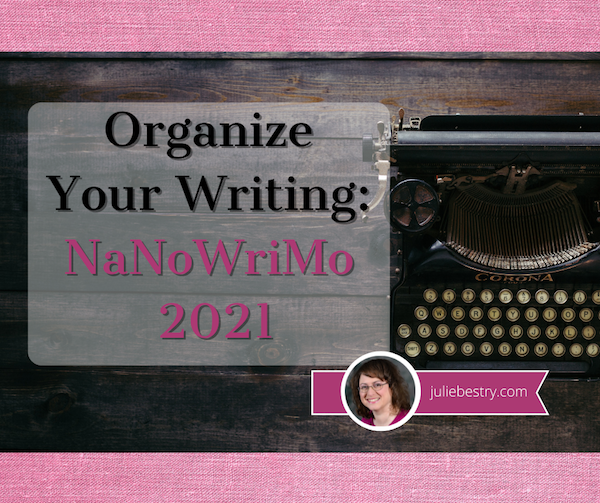
Photo of Typewriter by Patrick Fore on Unsplash
It’s November, and that means it’s time for NaNoWriMo.
Not familiar with National Novel Writing Month? You will be, by the time you finish this post. Not a writer? That’s OK, because many of the resources and concepts are applicable to your goals of getting organized at school, at work and in your life.
THE BASICS OF NANOWRIMO
Every November, NaNoWriMo participants commit to writing a 50,000-word novel between the first and 30th of the month. You’re encouraged to start planning and outlining in October, but all that matters is that starting after midnight (in your local time) on November 1st, you start writing a new novel (or a fresh rewrite of an old one), and aim to finish before the end of the month. Each day, you can update your progress and get cute little badges (if that’s your style).
There are plotters (people who create detailed outlines) and pantsers (those who prefer to write by the seat of their pants. (Not sure whether you’re a plotter or pantser? SkillShare Blog has some guidance.) And there are rebels, who aren’t writing novels at all, but screenplays, non-fiction, comic books (though, I suppose a graphic novel is nonethless a novel).
If you’re enough of a rebel to pick a different format, but not so much of a rebel that you’d independently write without thousands of others doing the same thing you’re doing, it’s OK. The NaNoWriMo police won’t strip you of a win if your creation looks less like a novel and more like an epic poem, Iliad & Odyssey-style.

Once you have hit the 50,000-word benchmark, you can upload your novel and the NaNoWriMo website will verify your word count. If you hit that 50K, you’re a “winner!” (Whoohoo!) That means you’ll get a certificates and a banner you can display on social media and your website, and you can purchase a T-shirt in the site’s store. And you’ll have the righteous satisfaction of knowing you can write a book, even if you don’t choose to publish or even share it with anyone.
During the course of the month, you can benefit from a variety of writing and productivity assistance and accountability support:
- Discussion Forums
- Writing Groups
- Regional Support
- Writing Buddies
- Pep Talks from Professional Writers (including past talks from lots of writers you probably already read!)
Of course, as a Paper Doll reader, you already know the importance of accountability, but as a reminder, you may want to peek back at:
Count On Accountability: 5 Productivity Support Solutions
Flow and Faux (Accountability): Productivity, Focus, and Alex Trebek
What really excites many NaNoWriMo peeps are the various special offers available to participants and to “winners” (i.e., those who hit their 50K goal). From discounts on writing software like super-platform Scrivener, to book-planning Plottr, to grammar-checker/style editor ProWritingAid, participation has its privileges.
A BOUNTY OF RESOURCES
In 2015, I wrote Organizing Your Writing for NaNoWriMo and More. I talked about creating a road map and preparing to write, setting a schedule, creating a theme song to psych you up for writing, conquering writer’s block, and staying motivated. I anticipated it would be a one-time kind of post, because organizing writing seemed like a narrow focus. Readers thought otherwise, and I kept getting request for most posts on the topic.
So, in 2017, I revisited the concepts of organizing your writing for a month-long series of NaNoWriMo posts. There’s a bounty of information and resources in these posts from the vault, and I’ve added some bonus information below; I’ve checked (and where necessary, replaced) the links and removed (or warned about) anything that’s no longer valid.
[Note: because the posts were originally from 2017, various software and services have increased in prices, and because we live in a world where capitalism abounds, those rates will surely go up again, so rather than chasing down price changes for each, I encourage you to check rates before purchasing anything.]
Of course, I’m not just going to tell you what I wrote about in years-ago posts. Halloween may be over, but there are treats below!
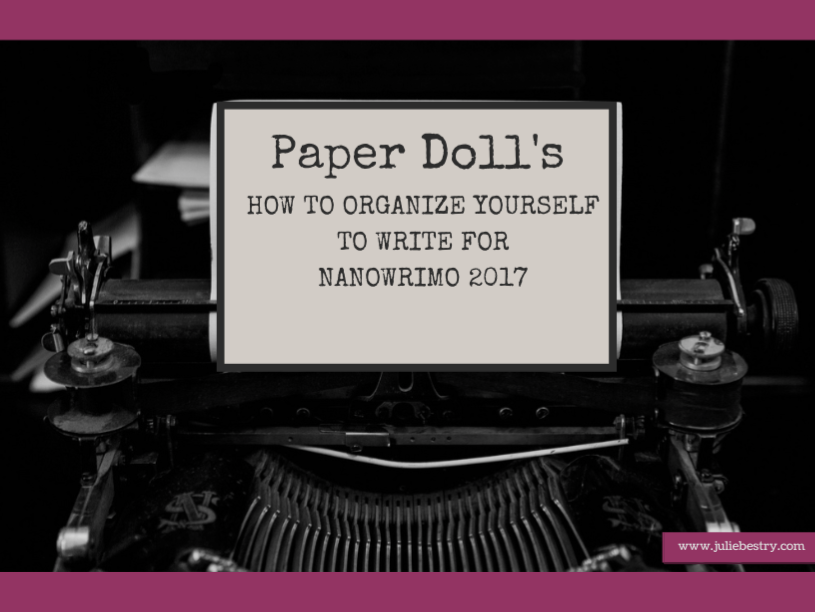
(I think this was my first attempt at create a graphic in Canva. A writer, I am. A designer, I am not.)
Paper Doll’s How To Organize Yourself to Write for NaNoWriMo 2017
This post covered how to:
Identify your goals — this is key to any project. You’ve heard of SMART goals, where it’s essential to create goals that are specific, measurable, attainable, relevant, and time-based? Well, with my organizing clients, I always make sure that the reason we’re working is based on SMARTY goals — that Y assures that your “why” is based on YOUR goals. Just as it’s hopeless to get organized to solely to please your mother-in-law or to lose weight so your significant other will pay more attention to you than the TV, your goals for why you want to write are as unique as you are, and the post lays out four possible ways to reach your Y/why.
Organize your inspiration — Some of us are motivated by the carrot, others by the stick. (Of which, more later.) Some of us, like my writer-pal Dava Stewart of Smiling Tree Writing, get motivated by embracing nature. Paper Doll, on the other hand, needs an air-conditioned, bug-free environment without the sound of crickets or frogs.
Organizing your writing time — I teach my clients, “Don’t put things down, put them away.” The word away ensures that something has a home, where it lives. Just as with tangible items, tasks and projects require homes in your schedule if you hope to accomplish them. Remember, someday is not a day on the calendar!
Don't put things down, put them away. AWAY ensures that something has a home. Just as with tangible items, tasks require homes in your schedule. Remember, SOMEDAY is not a day on the calendar! Click To TweetThat post also offered some suggestions for seeking expert advice. If any of these issues resonate with you, that first NaNoWriMo post from 2017 is worth a visit.
Paper Doll’s NaNoWriMoMoMo (Novel Writing Month Monday Motivation)…Even for Non-Writers
This post was a compendium of advice about motivation. Everyone’s motivation has suffered over the course of the pandemic, and inspiration has been hard to come by. This post pulled from different resources to help amp up motivation to get started and keep going. Plus, who else but Paper Doll would offer up a post with Confucius, Kermit the Frog, and Hugh Jackman?
If your spirit is willing but your flesh is weak, sleepy, and full of Halloween candy, the above post should give you a motivational boost. (You could also send all your leftover Reese’s Peanut Butter Cups my way; sharing is caring, and what better way to be motivated than to share your bounty?)
Paper Doll’s NaNoWriMoMo(nday): Organize Your Writing Platforms for Maximum Focus
Sure, you can write the Great American Novel in Microsoft Word, but the truth is, most writers need a little more support from their writing platforms. This post covered the beloved Scrivener, which is probably the best-known and most beloved, as well as the most sworn-at writer’s software around. It has so many bells and whistles for organizing your writing and research and giving you the equivalent of surround-sound (surround-vision) of bulletin boards, note cards, and success-tracking that it can be overwhelming.
I also guided you toward the amazing resource of Joseph Michael, founder of Learn Scrivener Fast. Watch his Twitter account for announcements of his free webinars to get a taste of how much of a wealth of experience he has to offer to provide clarity about Scrivener. Today, I add the advice to get to know Anne Rainbow of Scrivener Virgin. She’s another tremendous resource for learning the best ways to organize your writing and research.
The post also reviewed a number of minimalist platforms designed to help narrow your focus and keep your eyes on the writing ball. These included IAWriter, Ulysses, Ilys (which literally keeps you focused by only letting you see one letter at a time, preventing you from editing and getting lost in writerly analysis paralysis), Zen Pen, and The Most Dangerous Writing App In the World. In terms of carrot and stick approaches to focus, the latter is the ultimate stick; you set the time frame (5 seconds? a minute?) but if you stop writing for longer than the amount of time you’ve allowed, everything you’ve written gets deleted. Permanently. (Prefer a carrot to a stick? Keep reading!)
Paper Doll’s NaNoWriMoMo(nday): 10 Tools to Organize Your Writing, Editing, and Proofreading
Writing comes from the heart, but creating good writing that people are willing to read means that you need to address the technical aspects. Ernest Hemingway said, “Write drunk. Edit sober.” And many of the solutions I offered were more for the post-NaNoWrimo editing stage of the writing experience.
I wax eloquent and gushed about my beloved Jumpcut, a (free) Mac menu-bar doohickey that lets you do the “and paste” part of cut-and-paste or copy-and-paste, even if you cut something six cuts ago and forgot to paste it. Jumpcut remembers. Unfortunately, it looks like the PC clipboard manager I suggested has gone to the website graveyard, other free solutions exist. If you tend to copy but forget to paste, or realize too late that you want a snippet you’ve written back again, Softclick has compiled a list of clipboard managers for Windows.
The post also covered proofreading and editing tools like Grammarly and Hemingway, to which I’d now add ProWritingAid for those wanting business-class editing support (and are willing to pony up $20/month or $79/year for a 67% discount, or $399 for a lifetime subscription). I also looked at online dictionaries and text expanders for automating your snippets of repeatable brilliance.
Paper Doll’s NaNoWriMoMo(nday): Writing Challenges, Dictation Tools, & Organized Writing Advice
This series-ender was a bit of a mish-mash. It looked at the concept of other kinds of writing challenges as well as writing support software and services for dictation, and rounded out the month with a stack of NaNoWriMo advice. (Stick around for more of that good stuff!)
But you didn’t think I was just going to update you on a four-year-old blog series, did you?
CARROT VS. STICK
In the original post, Organize Your Writing Platforms for Maximum Focus, one of the platforms (The Most Dangerous Writing App in the World) took the stick approach. That might work for getting your juices flowing writing what Julia Cameron, author of The Artist’s Way, calls morning pages. But if the first decent draft of chapter 3 went up in a puff a smoke because you stopped too long to admire it, I suspect you wouldn’t be very inspired to keep writing. The stick may motivated, or it might beat you into submission!
For some people, avoiding pain is the best way to spur them along. But others prefer the carrot — the reward. For them, consider:
Are you having trouble getting going on something you need to write? Maybe a novel, but maybe a report for work, a long-overdue note of gratitude? Just plunk down with The Official Written Kitten in your browser.
The setting are simple. Would you like to be rewarded with a new photo of a kitten, a puppy, or a bunny? And would you like your reward to come every 100, 200, 500, or 1000 words? Pick the adorable animal and number count of your liking, and start typing in the box. Once you hit your benchmark, a box to the right of your writing area will be filled with a “fresh” photo of an cuddly friend, such as Little cat with beautiful eyes looking at camera by shixart1985.
Once you hit your goal, be sure to copy the content to Word, Google Docs, email, or wherever your final destination may be to save your creation. If you click the share buttons under the photos, that pop up, your Twitter or Facebook followers will see the adorable animals (selected from Flickr), but not what you’ve written.
MAKING GOALS, BREAKING THEM DOWN
50,000 words sounds like a lot, even over a month’s time. Divide that equally by 1667 words sounds a bit more manageable. (For a hint, that’s about half the length of a typical Paper Doll post.) And certainly, you could aim for 1667 words per day. But realistically, not everyone’s life rolls steadily along with an equal number of pockets of time available for writing.
Certainly, time blocking is one solution. And for that, harken back to last February’s Playing With Blocks: Success Strategies for Time Blocking Productivity for a deep dive in how blocking your time will help make sure nothing falls through the cracks in your busy, busy life.
Pacemaker is one interesting resource for trying to organize your writing slots. It’s designed as a simple, flexible goal planner for writers and students to help making writing projects seem less overwhelming. Whether you’re NaNoWriMo-ing or trying to finish your thesis, Pacemaker can help you sort out the possible writing pathway. Pacemaker notes you can try one of multiple methods to do work in a set block of time (month, quarter, year, etc.):
- Steady — With this pattern, you aim to write the same amount (whether that’s number of words or number of pages) each day.
- Rising to the Challenge — Think of this as akin to how you build up your number of reps at the gym. While the number of words written starts out small, if you increase your word count quota each day, you’ll build up that writing muscle.
- Biting the Bullet — For some people, baby steps don’t work; instead of rising slowly to the challenge, this method encourages tackling large chunks of your writing goal at the beginning of your schedule so that the pressure is off as the days taper down. Given that NaNoWriMo takes place in November, with Thanksgiving travel (in non-pandemic years, at least) and holiday prep taking up lots of the end of the month, this might be ideal for those with big end-of-the-month plans.
- Mountain Hike — Too freaked out to bite the bullet, too busy near the end of the month to rise to the challenge? This strategy puts the bulk of your effort at the center of your period.
- Valley — This effort is the reverse of the mountain hike. Work hard at the start and the end, but give yourself some leeway in the middle.
- Oscillating — This strategy mixes heavier and lighter loads, but in a regulated way.
- Random — Some people function better when their obligations are a surprise. Paper Doll generally avoids surprises; I like to have everything neatly planned out. Surprises give me hives. But if not knowing what to expect revs your engine, perhaps being asked to write 500 words on Tuesday but only 27 words on Wednesday might be right up your alley. And Pacemaker notes that there are 20 million googol different ways to write 50,000 words in 30 days so if you pick the randomized route, you’ll never get bored!
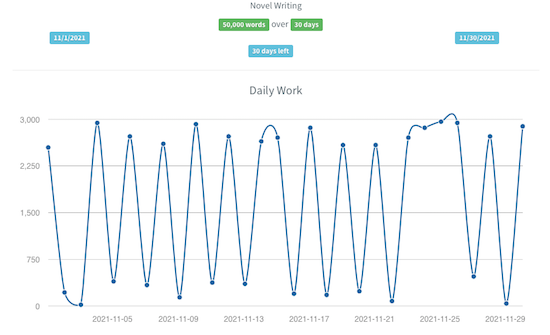
(This is the random method; if you were looking at the actual graph instead of a screen shot, you could hover your cursor over any dot to see how many words you should write.)
Pacemaker lets you customize further by deciding if you want to do more, less, or nothing on the weekends. You can also select an intensity of work, on scale from gentle to hard core, and even reserve some number of free days at the end!
So, with Pacemaker, you set up a plan by naming your project and determining what you’re trying to accomplish. (While Pacemaker is writing-friendly, you can also set it up for a variety of other related or unrelated projects, from editing and proofreading to saving, spending, running, training, and more.) If you are writing, you can pick a project type, like novel, conference paper, dissertation, speech, etc.
Next, set your goals, including length and length type. So, you can pick 50,000 words to finish a novel for NaNoWriMo, or 250 stanzas for your epic poem, or 13 verses for your song to rival Alice’s Restaurant (another November tradition). Then note your start and finish dates.
You log your efforts as you go along, and then they’re displayed for you however you prefer: as a table, graph, calendar, or bar chart (though that’s a premium feature). Below is the calendar version of a randomized Pacemaker attempt at a novel in one month.
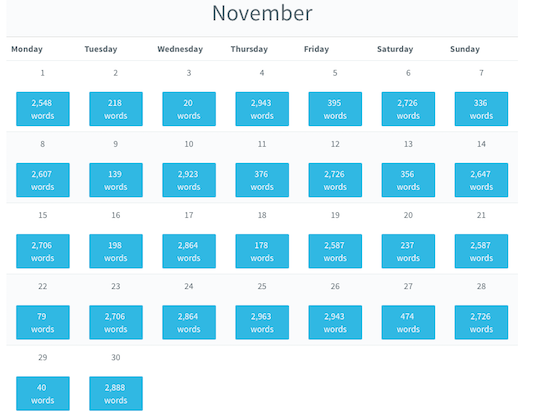
Check out their sample plans. Pacemaker is free, but there’s a premium version for $8/month or $72/year.
TRACKING YOUR SUCCESS
What we measure, we pay more attention to, and are thus more likely to improve. We tend to think of keeping score as a having a competitive purpose, but we need not compete against anyone but ourselves. Measuring the results of our efforts, and tracking them over time, gives us a reality check that helps us refine and tweak what we do.
When we’re watching our weight, tracking the numbers on the scale may help, or may demoralize us; noting whether we’re wearing the jeans that are one size up (or down) from what we wore last season may be a bit more compelling. Whether we’re tracking how much we’re saving for a big purchase (or paring down our debt), whether we’re tracking our scores on practice tests or our words written toward a goal, knowing how we did is a powerful resource!
Austin Kleon adapted a simple “Don’t Break the Chain” printable from his popular The Steal Like an Artist Journal to help make sure you keep up with NaNoWriMo (or any thirty-day challenge).
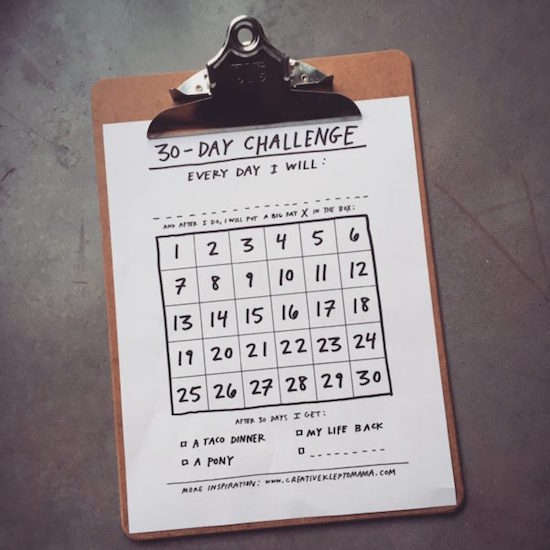
©2017 Austin Kleon
I like the fact that it doesn’t merely give you a chance to put “a big, fat X” through any day you’ve worked toward your goal, but there’s a choice of “carrots” (just like the kittens in Official Written Kitten) at the bottom to remind you how you’ll reward yourself. Kleon’s carrots are a “a taco dinner,” “a pony,” and getting your “life back” but there’s a space to put your own reward.
And once again, I want to encourage NaNoWriMo-ites (and anyone else) to investigative designer Dave Seah‘s free 2021 NaNoWriMo Word Counting Calendar.
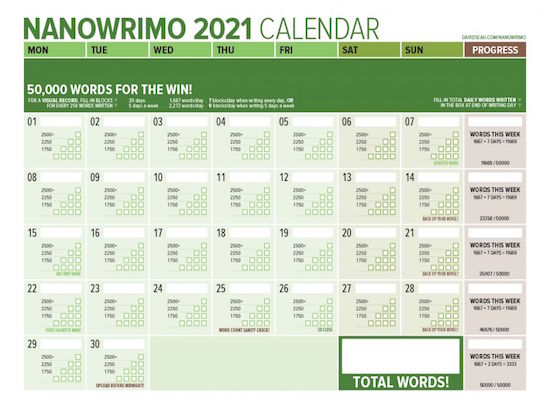
©2021 David Seah
There are six different color versions; the classic PDF version is green, but I’m partial to the pink and purple, and there’s also blue, orange, and noir-ish black & white.
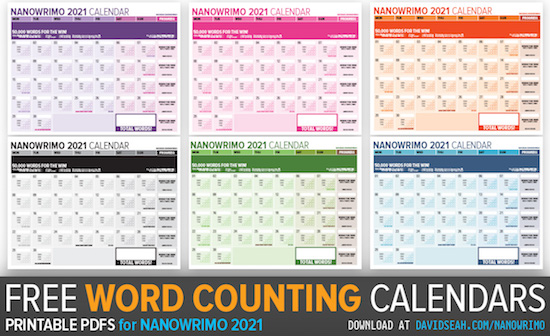
©2021 David Seah
ORGANIZE YOUR MIND FOR NANOWRIMO AND OTHER (WRITING) PROJECTS
Participating in NaNoWriMo this Year? Here’s How to Make it Through — My favorite tip is #9, to celebrate your wins and ignore your losses. However, sometimes looking at our losses gives us an opportunity to identify how we can improve on our efforts — at writing, but also at organizing, getting in shape, or handling projects — the next time. So maybe we should celebrate our wins, not take our losses personally, but let them be instructive tools.
Write a 50,000-Word Pulp Novel Before Breakfast: My easy no-outline way of writing short novels in four weeks — Even if you’re not going to write a pulp novel, there’s good writing and project management wisdom here.
The NaNoWriMo Survival Guide: Advice from Past Winners
On Writing: The Only NaNoWriMo Tips You’ll Ever Need
Your Essential Guide to Completing NaNoWriMo in Evernote
10 Steps to Get Started with Scrivener for NaNoWriMo
And, finally, in case you feel like you need more training and inspiration in writing, Open Culture has a list of free online writing (and journalism) courses. They’re all MOOCs (massive open online courses) from US and international universities. From classes on creative writing and the crafts of character, plot, and setting at Wesleyan to advanced grammar and punctuation at UC Irvine, maybe feeliing like you’re back at school will help you get into the swing of writing.
Whatever projects you work on this month, remember to make sure the goals are truly yours, that you block space in your schedule and break down the tasks into small, workable elements, and that you track your accomplishments to stay motivated.
Happy November, and happy NaNoWriMo from YoLoPaDo, your loving Paper Doll.





Follow Me